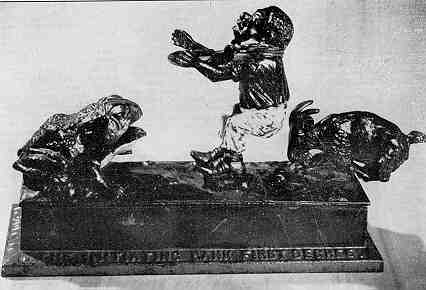Initiating Bank First Degree
by F.H. Griffith - HOBBIES Magazine - November, 1952

According to tradition there was a time when secret societies and fraternal organizations used a goat in their initiation proceedings. Typical of these times, with its obvious reference and name, is the Initiating Bank First Degree, our choice to occupy fourteenth position in the numerical classification of mechanical banks.
The Initiating Bank was patented in 1880 by George W. Eddy of Plainville, Conn., and assigned to Mechanical Novelty Works of New Britain, Conn. Mr. Eddy was one of the owners of this company and they made a number of mechanical banks during this period of the 1880’s. One of the banks they manufactured was a companion to the Initiating Bank First Degree and it was called the Initiating Bank Second Degree. This is known today as the Goat, Frog, and Old Man Bank which is merely a more descriptive title as there is no name inscribed on this bank.
It might be well to point out that many of the banks have been given names that are descriptive of the bank itself. The reason for this, of course, is to enable dealers and others who aren’t too familiar with mechanical banks to identify them more easily. This has been necessary to a large degree due to the fact that many of the banks have no name inscribed on them. For example, it would be difficult to identify Paddy And His Pig as the Shamrock Bank which is the name it originally went by when sold in stores. The same applies to French’s Automatic Bank now called Boy On Trapeze and Baby Mine, now called Mammy and Child, and others. Even some banks with names inscribed on them have been given another name to better identify them. As example, the Motor Bank now commonly called the Trolley Car Bank. It does seem best, however, to leave well enough alone and use the name that is inscribed on the bank.
The Initiating Bank shown was adopted some years ago from Bob Spar of Canton, N.Y. The bottom base plate was missing and there was a crack across the top where the goat is fastened to the bank. A base plate was supplied through the help of the late James C. Jones. The crack was repaired by means of welding using wet asbestos to protect the paint. This method of repair carefully done left no sign of the break and preserved the original paint. A minimum amount of touching up with matched paint right at the former crack finished the job.
The bank operates as follows: The goat is pushed down into the position shown in the picture and the frog automatically sits down on the base at the same time. A coin is placed on the plate held in the darky’s outstretched hands, the lever located in front of the goat is pressed, and he lunges forward butting the stooped-over figure in the rear. The figure falls forward and the frog raises on his hind legs to receive the coin in his mouth. The action is well timed, and the coin goes through the frog’s body into the base of the bank.
The name The Initiating Bank First Degree is inscribed on each side of the bank along the beveled edge of the base. On one end of the base is the word "Eddy’s" and on the other end is the word "Patent". It is painted in attractive colors, the darky with a red scarf around a white collar and yellow trousers, the goat and frog in a brownish lacquer, with the frog having a red and yellow mouth and green head. The base is green on top with brown lacquer sides and red trim on the beveled bottom edge.
The Initiating Bank is one of the largest of the mechanical banks in overall size. Because of its action it has a special appeal to the men who collect banks. Also, it is one of the more difficult banks to find in good condition due to the operation and method whereby the figures are attached. A little rough treatment by a child and these would break off very easily.
The exact number of the Initiating Banks that have survived and exist in collections today is not certain. However, it is a limited number and any collector that does not already have one will rate it among the top to obtain for his collection.
A point of interest is that the figure of the so-called frog is actually a toad, however, its mouth is painted like that of a frog.
